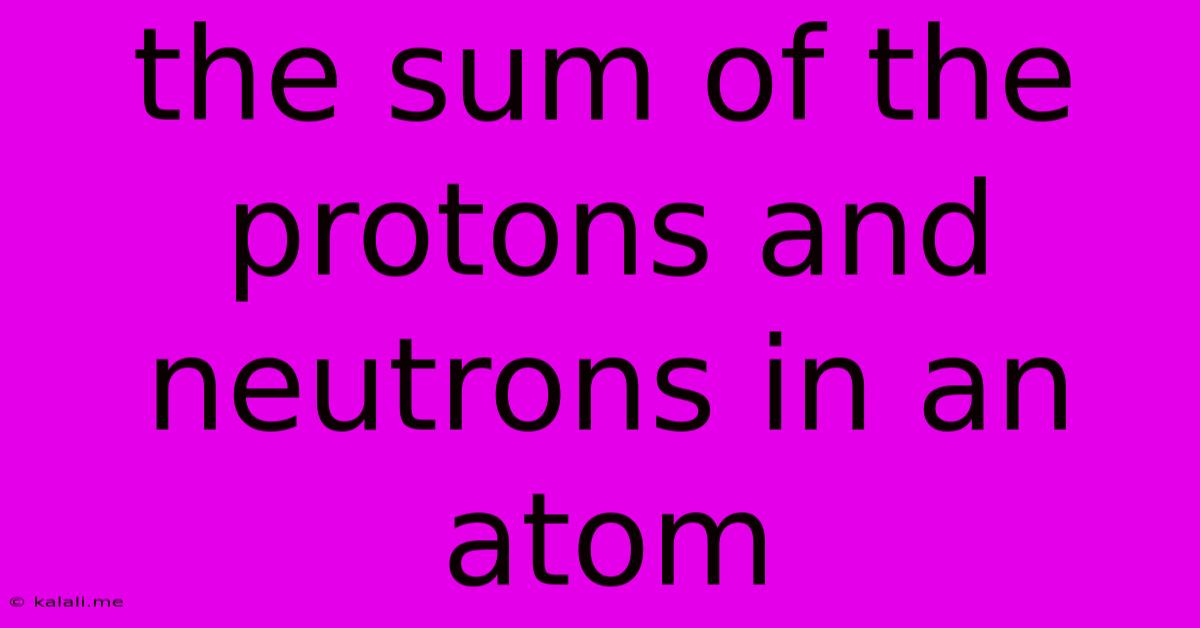The Sum Of The Protons And Neutrons In An Atom
Kalali
Jun 13, 2025 · 3 min read

Table of Contents
Understanding the Sum of Protons and Neutrons in an Atom: The Atomic Mass Number
The sum of protons and neutrons in an atom's nucleus is a fundamental concept in chemistry and physics, known as the atomic mass number (also called the mass number). Understanding this number is crucial for comprehending the properties and behavior of elements and isotopes. This article will explore the significance of the atomic mass number, its relationship to isotopes, and its use in various scientific applications.
This article will cover: what the atomic mass number represents, how to calculate it, the difference between atomic number and mass number, and the implications of variations in the mass number.
What is the Atomic Mass Number?
The atomic mass number represents the total number of nucleons within an atom's nucleus. Nucleons are the particles found in the nucleus – specifically, protons and neutrons. Protons carry a positive charge, while neutrons are electrically neutral. The atomic mass number is denoted by the letter 'A' and is typically written as a superscript to the left of the element's symbol (e.g., ¹²C for carbon-12).
The significance of the atomic mass number lies in its direct correlation to an atom's mass. Since protons and neutrons have approximately the same mass, the atomic mass number provides a close approximation of the atom's total mass. While electrons also contribute to the overall mass, their mass is negligible compared to that of protons and neutrons.
Calculating the Atomic Mass Number
Calculating the atomic mass number is straightforward. Simply add the number of protons (atomic number, Z) and the number of neutrons (N) in the nucleus:
A = Z + N
For example, a carbon-12 atom (¹²C) has 6 protons and 6 neutrons. Therefore, its atomic mass number is 6 + 6 = 12.
Atomic Number vs. Mass Number: Key Differences
It's important to distinguish between the atomic number (Z) and the atomic mass number (A). The atomic number identifies the element and represents the number of protons in the nucleus. This number is unique to each element and determines its chemical properties. The mass number, as previously discussed, is the total number of protons and neutrons.
Different isotopes of the same element share the same atomic number but have different mass numbers due to varying numbers of neutrons.
Isotopes and Mass Number Variations
Isotopes are atoms of the same element that possess the same number of protons but differ in the number of neutrons. This difference in neutron number leads to variations in the atomic mass number. For example, carbon has several isotopes, including carbon-12 (¹²C, 6 protons, 6 neutrons), carbon-13 (¹³C, 6 protons, 7 neutrons), and carbon-14 (¹⁴C, 6 protons, 8 neutrons). All three are carbon atoms because they all have 6 protons, but they have different mass numbers (12, 13, and 14, respectively) due to varying neutron counts. These variations in mass number influence the stability and radioactive properties of isotopes.
Applications of Atomic Mass Number
The atomic mass number finds applications in various fields, including:
- Nuclear physics: Understanding the mass number is essential for studying nuclear reactions, radioactive decay, and nuclear stability.
- Chemistry: It helps in determining the average atomic mass of an element, considering the abundance of its various isotopes.
- Mass spectrometry: This technique uses the mass-to-charge ratio of ions to identify and quantify different isotopes, relying heavily on the mass number concept.
- Geochemistry and Radiometric Dating: Isotope ratios and their associated mass numbers are crucial in determining the age of geological samples and artifacts.
In conclusion, the atomic mass number, representing the sum of protons and neutrons, is a critical concept in understanding atomic structure and behavior. Its relationship to isotopes, its role in various calculations, and its widespread application across multiple scientific disciplines highlight its fundamental importance in the world of science.
Latest Posts
Latest Posts
-
Common Factors For 84 And 105
Jun 14, 2025
-
Which Color Is Not A Primary Color
Jun 14, 2025
-
What Is The Difference Between A Square And Rhombus
Jun 14, 2025
-
The Normal Rbc Graveyard Is The Liver
Jun 14, 2025
-
Can You Reschedule A Sat Test
Jun 14, 2025
Related Post
Thank you for visiting our website which covers about The Sum Of The Protons And Neutrons In An Atom . We hope the information provided has been useful to you. Feel free to contact us if you have any questions or need further assistance. See you next time and don't miss to bookmark.